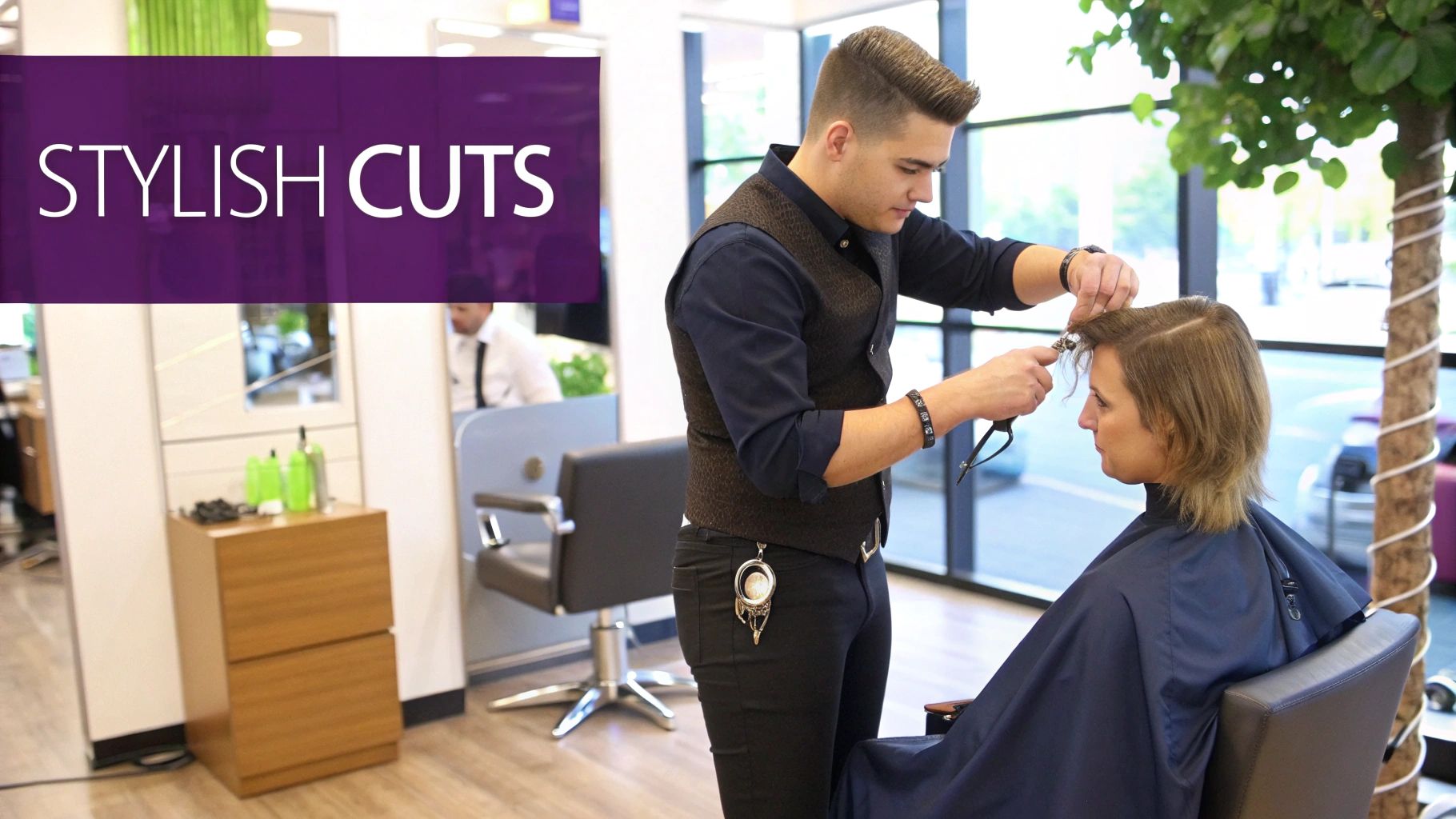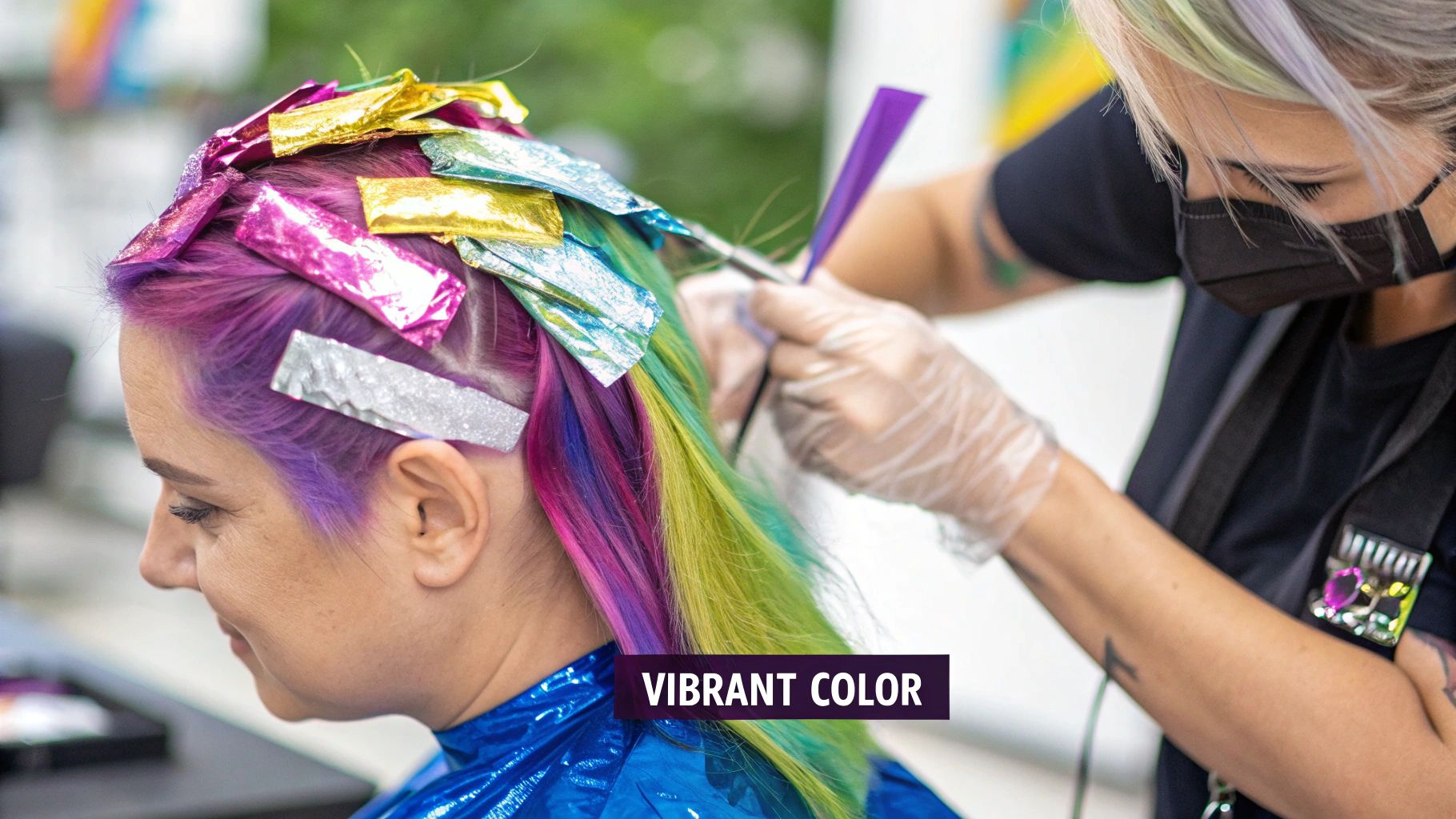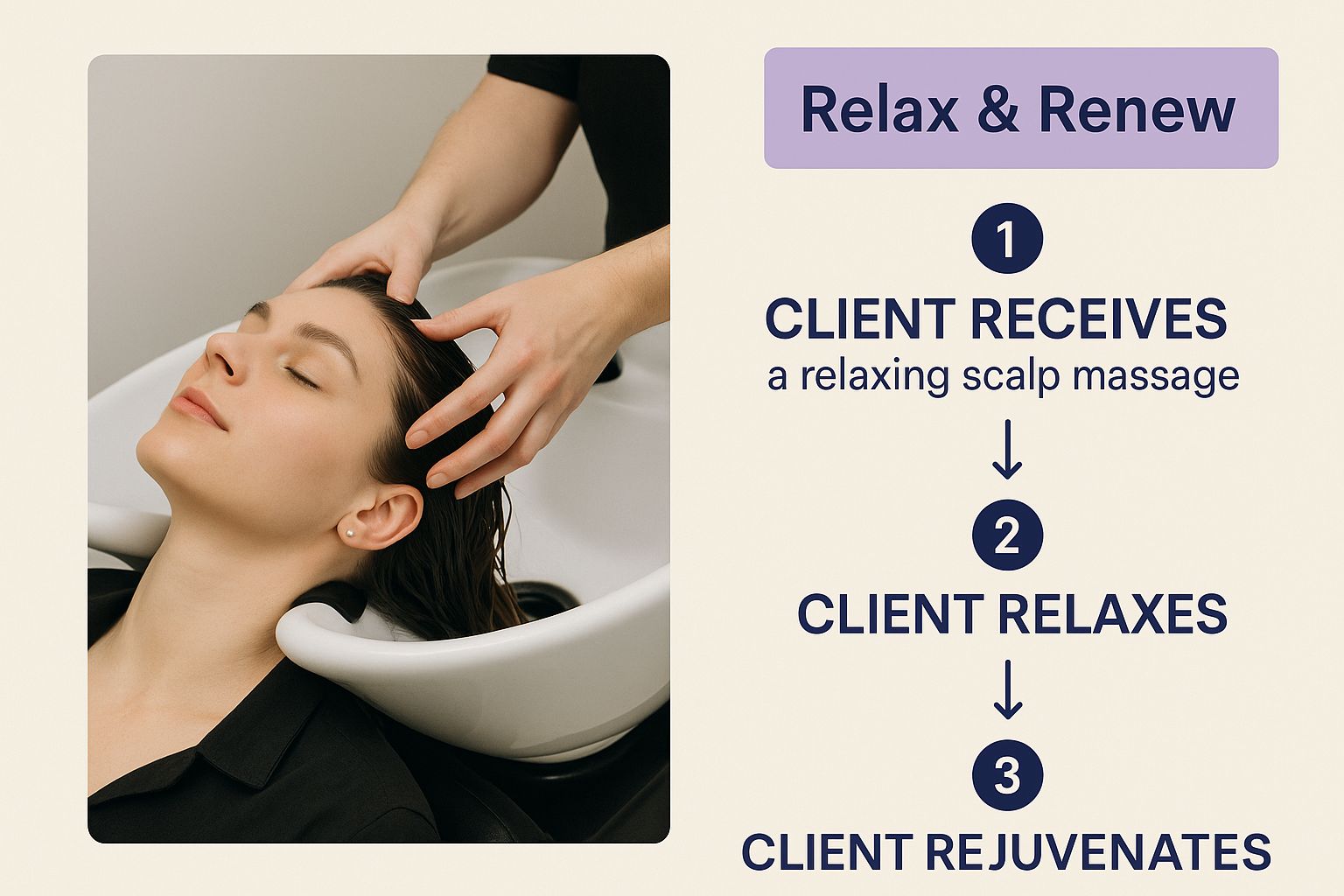Build a Better Salon Service Menu That Sells

Think of your salon service menu as more than just a price list—it’s your most powerful, silent salesperson. A well-designed menu does the heavy lifting for you, guiding your clients' choices, showing off your salon’s unique vibe, and seriously boosting your average ticket. With the right layout and descriptions, you can make clients feel understood and excited to book before they even speak to a stylist.
Why Your Menu Is More Than Just a Price List

Your salon service menu is the centerpiece of your brand strategy. For many potential clients, it’s the first real, detailed interaction they have with your business, and it sets the tone for everything that follows.
A cluttered, confusing menu can create instant friction and make a client second-guess booking. But a clear, beautifully designed one? That builds trust and excitement right from the get-go. This isn't just a document that lists what you do; it tells a story about your salon's expertise, the quality you stand for, and the specific problems you solve for your clients.
The Psychology of a Great Menu
A thoughtfully designed menu uses subtle psychological cues to influence what clients book. The way you group services, what you name them, and how you write the descriptions can make a massive difference in what your clients choose to book.
For instance, try organizing services by client goals—think categories like "Volume & Texture" or "Ultimate Relaxation"—instead of just "Haircuts" and "Color." This simple shift helps customers find solutions, not just services. It positions you as the expert who understands their needs.
Your menu isn't a transactional tool; it's a consultative guide. It should anticipate and answer questions your clients haven't even thought to ask yet, showcasing your expertise and building their confidence in you before they even sit in your chair.
This approach turns booking from a simple chore into a curated experience. It also opens up the perfect opportunity to increase customer lifetime value by creating packages and add-ons that clients genuinely want and appreciate.
Capitalizing on a Growing Market
Let's talk numbers. The salon industry is absolutely booming. The global market is projected to skyrocket from USD 232.6 billion in 2025 to a massive USD 429.8 billion by 2035.
What’s driving this? Social media trends and a bigger-than-ever focus on personal grooming mean more clients are actively hunting for new and specialized treatments. You can get into the nitty-gritty of what's fueling this growth in this detailed report.
Your menu is the primary tool you have to grab a piece of this expanding pie. When you present your services in a compelling, expert way, you position your salon to attract those discerning clients who are ready and willing to invest in high-quality, professional care.
Choosing Services That Actually Make Money

It’s easy to fall into the trap of offering every service under the sun. But a bloated menu is a classic mistake that leads to a burnt-out team and lower profits. The real goal is to curate a list of services that are not only in demand but are also highly profitable.
Building a killer salon service menu starts with a strategic audit of what you already offer.
First, dive into your salon's data. Run a report in your booking software to identify which services consistently bring in the most revenue. More importantly, which ones have the best profit margins after you subtract product costs and your team's time? You might discover that your most popular service isn't your biggest moneymaker. This insight is gold for making smarter business decisions.
Once you’ve identified your top performers, have an honest conversation with your team about their skills and passions. What do your stylists actually love to do? A stylist who lives for creative color will sell that service with more confidence and artistry than someone who prefers classic cuts.
Don't build a menu based on what you think you should offer. Build it around the services your team excels at and genuinely enjoys providing. Passion translates directly into a better client experience and higher-quality results, which are your best marketing tools.
This focus helps you carve out a real niche and become the go-to salon for specific, high-value treatments.
Identify Gaps in Your Local Market
Now it's time to play detective. Take a look at the menus of your local competitors—not to copy them, but to find what’s missing. Are all the other salons in town focused on balayage, but nobody is a true expert in textured hair or vivids? Spotting those gaps is your golden ticket to standing out.
Keep an eye on emerging trends, too. The salon hair care market was valued at a whopping USD 190.22 billion in 2024, and it's always changing. For example, recent data shows that 68% of male clients are visiting salons more often, with many booking multiple services in a single visit. This points to a huge opportunity in specialized men's grooming that your salon could own. To dive deeper, you can read more about salon hair care services trends.
By performing this audit, you can finally remove low-margin, low-demand services that are just keeping you busy. This lets you refine your offerings and build a menu that pulls in your ideal clients while maximizing your bottom line. A smaller, more focused menu almost always leads to a healthier, more profitable business.
Setting Prices for Profit and Value
Figuring out how much to charge is one of the trickiest parts of building a salon service menu that makes money. It's a balancing act: you need to cover your costs, demonstrate the value of your skills, and stay competitive. Nail this, and you've got a sustainable business. Get it wrong, and you're on a fast track to burnout and financial stress.
The first step is to stop guessing. You have to calculate your true cost-per-service, and that means including everything that goes into the client experience, not just the product.
Calculating Your True Service Cost
To price for real profit, you need a solid formula that accounts for direct costs, overhead, and your team's time. Think of it as creating a recipe for every single service on your menu.
Here’s a clear, actionable breakdown:
- Product Costs: The easiest part. Tally up the exact cost of every product used for a service, from foils and developer down to the finishing spray.
- Labor Costs: This is your stylist's commission or hourly wage for the time the service takes. Don't forget to include payroll taxes and any benefits.
- Salon Overhead: The most overlooked cost. Add up all your monthly operational expenses—rent, utilities, insurance, marketing, booking software, etc. Divide that total by your total service hours for the month to get an hourly overhead rate. Apply that rate to each service based on how long it takes.
Let's break down the costs for a common service like balayage to see this in action.
Sample Service Cost Calculation
| Cost Component | Example Calculation (Balayage Service) | Estimated Cost |
|---|---|---|
| Product Costs | Color, developer, lightener, toner, foils, shampoo, conditioner, styling products | $25 |
| Labor Costs | Stylist commission (45%) on a 3-hour service priced at $250 | $112.50 |
| Overhead | Hourly overhead rate ($20/hr) x 3 hours for the service | $60 |
| Total Cost | Sum of all components | $197.50 |
| Profit | Service Price ($250) – Total Cost ($197.50) | $52.50 |
This table shows that without knowing your numbers, you could easily underprice a complex service and barely make a profit. Once you have this data, your pricing decisions become strategic, not emotional.
By calculating your actual cost for every single service, you eliminate emotional pricing. The numbers tell you exactly what you need to charge to not just break even, but to thrive and reinvest in your business and team.
Choosing the Right Pricing Model
Once you know your baseline costs, you can pick a pricing structure that fits your brand. A popular and effective approach is tiered pricing. With this model, your prices are based on a stylist’s experience level—think New Talent, Senior Stylist, or Master Stylist. It gives clients different price points and creates a clear career path for your team.
Another model gaining traction is session-based or hourly pricing. You charge a flat hourly rate that includes all necessary treatments done within that time. This simplifies the menu and makes pricing transparent, which is perfect for complex color corrections or creative work where product usage varies. You can dive deeper into various hair salon pricing strategies to figure out which one aligns best with your business goals.
The Psychology of Add-Ons and Upgrades
Want to increase your average ticket without nickel-and-diming clients? Strategic add-ons are your best friend. These should be high-value, low-overhead services that enhance the client's main experience.
Think about how a simple add-on, like a relaxing scalp treatment, can completely elevate the client's visit while bumping up your bottom line.

This visual drives home the point: clients are often willing to pay a premium for the experience. To get a better feel for market rates on these treatments, look at guides on how much a facial typically costs, as they break down pricing factors for popular services. The key is to present these as luxurious upgrades, not just extra charges.
How to Organize Your Menu for Easy Booking
A confusing salon menu is a one-way ticket to a lost client. If someone can’t figure out what they’re looking for in a few seconds, they'll just leave your site. Your menu needs to be intuitive, guiding them from "just browsing" to "booked!" without any friction.
Think of it like setting up aisles in a boutique. You group things logically so people can find exactly what they need. The goal here is to make the decision to book with you a total no-brainer.
Group Services by Category
The most classic and straightforward way to organize your menu is by service type. This method is popular for a reason—it makes sense to clients. It’s familiar, clean, and effective.
Start by creating broad, top-level categories that act like signposts. This structure lets clients jump straight to the section they care about instead of scrolling through a massive, jumbled list.
Here are common categories that work well:
- Haircuts & Styling: Group all your cuts, blowouts, and finishing services here.
- Color Services: Break this down further into subcategories like Highlights, All-Over Color, and Creative Color to keep it organized.
- Treatments: The perfect home for add-ons like deep conditioning, scalp therapy, or glosses.
- Extensions: These are specialized, high-ticket services. Giving them their own category makes them feel exclusive and premium.
This approach works perfectly with an online booking system for salons, as it translates to a digital format with clickable menus, making the booking process smooth for your clients.
Organize by Client Goals
For a more modern, consultative approach, group your services by the results a client is looking for. This is a game-changer because it shifts the focus from what you do to what you can do for them. Instantly, you’re not just a service provider; you're a problem-solver.
This strategy is also brilliant for upselling. It helps clients discover services they didn't even know they needed. Someone searching for a fix for flat hair might find a texturizing treatment they would have ignored in a generic "Treatments" category.
When you organize your menu around client goals, you stop selling services and start selling solutions. This simple shift in perspective can transform how clients perceive your value and expertise.
Think about what your ideal client is searching for online and create benefit-driven categories.
Consider categories like these:
- For Volume & Texture: A perfect place for layered cuts, perms, and volumizing blowouts.
- For Smooth & Sleek Hair: This is where you'd feature keratin treatments, silk presses, and glossing services.
- For Ultimate Relaxation: Combine services like scalp massages, aromatherapy treatments, and extended conditioning masks to sell an entire experience.
When you think like your client, you create a menu that doesn't just list what you offer—it acts as a helpful guide that makes booking feel easy and exciting.
Designing a Menu That Reflects Your Brand
Your salon menu is much more than a list of services. It’s a first impression, a handshake, and a powerful piece of your brand story. Long before a client sits in your chair, the look and feel of your menu are telling them who you are—your quality, your personality, and your attention to detail.
A beautifully designed menu builds trust and gets clients excited to book. A cluttered, confusing one can plant a seed of doubt. The key is to treat your menu design as a direct extension of your physical salon space. Your colors, fonts, and layout should all align with your brand.
Choosing Your Design Elements
Every design choice sends a message, so make them intentional.
Start with your color palette. It should reflect your salon's atmosphere. A spa focused on wellness might use soft neutrals and calming greens. A trendy, high-energy salon could use a palette of bold, vibrant colors that pop.
Fonts are just as critical. Above all else, they must be legible. A classic serif font (like Garamond or Playfair Display) can create a feeling of elegance and tradition. For a more modern, clean feel, a sans-serif font (like Helvetica or Lato) is a great choice.
Here are a couple of actionable tips:
- Use White Space: Don’t be afraid of empty space. Cramming the page with text feels overwhelming. Generous spacing makes your menu easier to scan and gives it a more luxurious, high-end feel.
- Choose High-Quality Materials: For a physical menu, don't skimp on the paper. Investing in a good, heavy paper stock makes a huge difference. The weight and texture in a client's hand subtly communicate the quality of your brand.
The United States has the largest beauty salon market in the world, with an expected market size of USD 91.23 billion in 2025. This growth is fueled by a huge consumer focus on self-care. In a crowded market, a high-end menu design is one of the best ways to stand out and attract clients looking for premium experiences.
Writing Descriptions That Sell an Experience
Your service descriptions need to do more than just state facts. They need to sell the feeling, the result, the transformation. Instead of just listing the steps of a service, use descriptive, benefit-focused language that helps the client imagine themselves in the chair.
For example, don't just write "60-minute deep tissue massage."
Try something more evocative: "Release deep-seated tension and restore your mobility. Our targeted 60-minute deep tissue massage is designed to soothe sore, overworked muscles and bring a sense of calm to your mind." See the difference?
Your descriptions should answer the client's unspoken question: "What's in it for me?" Focus on the relaxation they'll feel, the confidence they'll gain, or the problem you'll solve.
This approach transforms a simple price list into a compelling sales tool. For inspiration on creating a visual impact in your salon, check out these menu board design ideas that can captivate clients the moment they walk in.
Print vs. Digital Menus
Finally, let's talk format. While a beautiful printed menu is a must for in-salon consultations, a digital version is essential for your website and online booking platform.
- Printed Menus: These offer a tangible, luxurious touchpoint. They are perfect for your front desk, waiting area, and for walking a client through their options during a consultation.
- Digital Menus: Your online menu must be mobile-friendly and easy to navigate. Interactive elements, like clickable service categories that expand for more detail, can significantly improve the online booking experience.
The most successful salons use both. By keeping the design cohesive across your printed and digital menus, you create a seamless, professional brand experience for every client, no matter where they first discover you.
Got Questions About Your Salon Menu? Let's Talk.
Even with the most beautifully designed salon service menu, questions will always come up. That's a good thing. Think of your menu as a living document—it should grow and adapt with your salon, your team’s skills, and your clients' needs.
Getting ahead of common questions helps you manage client expectations and keeps your menu working hard for your business. Let's dive into practical answers for maintaining a menu that feels fresh, fair, and gets people booking.
How Often Should I Update My Salon Menu and Prices?
Perform a full review of your service menu and pricing structure at least once a year. This is your time to be strategic. Analyze your sales data to see what’s selling, what isn’t, and where your profit margins are. While you can add new or seasonal services more often to keep things exciting, your core menu needs this solid annual check-up.
When it comes to pricing, plan to make adjustments every 12 to 18 months. This isn't about being greedy; it's about keeping pace with inflation, rising product costs, and the investment you make in your team's continuing education.
A friendly heads-up is non-negotiable. Always let your clients know about price changes 30-60 days in advance. This is your chance to reinforce your value. Frame it by explaining how the adjustment allows you to continue using premium products and investing in the advanced training they deserve.
What Is the Best Way to Announce Menu Changes to Clients?
Transparency and a positive spin are everything. Frame any changes around the benefits to the client, not just the bottom line for your business. Use multiple channels to ensure the message is clear and no one is surprised at checkout.
Here’s a simple action plan:
- Email Newsletter: Send a dedicated email to your client list. Explain the adjustments, but also get them excited about any new services you’re adding.
- Social Media Posts: Design a clean, on-brand graphic for Instagram and Facebook. In the caption, reinforce your commitment to quality and the top-tier experience you provide.
- In-Salon Signage: Place a simple, well-designed sign at your front desk. It’s a low-key way to inform clients and gives your team an easy way to start the conversation during checkout.
Instead of a blunt, "Our prices are going up," try this angle: "To continue providing the exceptional experience you love with the industry's best products, we will be adjusting our service prices on [Date]." It sounds professional, confident, and keeps the focus on value.
Should I Put Service Times on My Menu?
Yes, absolutely. Including an estimated service duration is a small detail that makes a huge difference in the client experience. It shows respect for their time and helps them plan their day—a massive win for busy clients.
It also helps your front desk and booking system. Clear time estimates lead to more accurate scheduling, which means fewer gaps in your day and a smoother workflow for your team.
Just be sure to use flexible language, as service times can vary. Using phrases like "Approx. 2 hours" or "Please allow 90 minutes" sets realistic expectations without locking your stylists into a rigid timeframe. It’s a simple touch that signals professionalism.
How Do I Create Service Packages That Actually Sell?
The secret to creating irresistible packages is to stop guessing and start using your data. The best-selling bundles are always the ones that group together services your clients are already booking.
Action Step: Open your booking software and run a report on the most common service pairings. Do clients who book highlights almost always add a toner and a blowout? That’s your package. Bundle them and offer a small incentive, like 10% off the total price.
Next, give your packages benefit-driven names. Ditch boring labels like "Cut, Color & Treatment" and go for something like "The Ultimate Refresh Package" or "The Blonde Maintenance Bundle." Names like these sell an experience, not just a list of services. By building packages based on real client behavior, you create offers that feel intuitive and are almost guaranteed to sell.
Ready to build a stunning website with a salon service menu that attracts and converts clients? gohappybeauty creates beautiful, SEO-optimized websites specifically for beauty professionals like you. Start building your dream salon website today!
Grow your beauty business
Our focus is, and always will be, helping you improve your online presence and generate more business from your website. That is what we do, for you.

